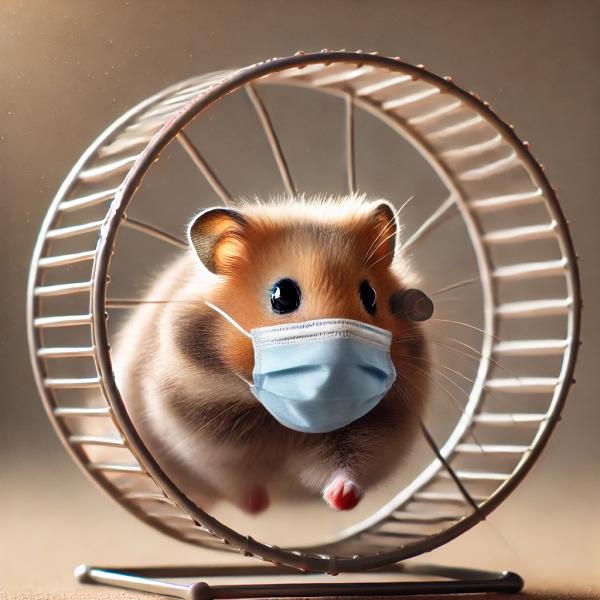
There is little doubt at this point that the COVID vaccines were oversold. While they reduce the severity of the illness, they do not prevent infections nearly as effectively. With the many mask and distance mandates and the all-too-human responses to those requirements, it is hard to tell whether vaccines reduced transmission. A new study shows that how the vaccine is administered can lead to no transmission – at least if you are a hamster.

The star of the study, reported in Science Advances, is the Syrian or Golden Hamster, a frequent though unheralded lab participant. COVID is transmitted through the air via viral airdrops and aerosols. Transmission from one individual to another was a vital feature of the pandemic, and many cases occurred when an essentially asymptomatic child brought home more than homework from school. To look at primary transmission, from an infected individual to an uninfected one (Contact 1, C1), and secondary transmission from that now infected individual to others (Contact 2, C2), the researchers developed a model where infected hamsters could have a chance to mingle with the uninfected, and in some cases, vaccinated hamster friends.
“Donor” hamsters were infected, and 24 hours later, they had an 8-hour playdate with primary contact (C1) hamsters. 24 to 72 hours later, these C1 hamsters had a play date with new hamsters, the secondary (C2) hamsters, for another 8-hour playdate. Some C1 and C2 hamsters were given an intramuscular version of the mRNA vaccine, while others received a currently used (in India) nasal vaccine delivered to the mucosa.
In testing the model, all of the donor and C1 hamsters developed infection, as measured by viral particles and genetic material. Substantial transmission, again measured by the presence of viral particles, was observed in C2 hamsters after a 72-hour incubation period for the C1 hamsters.
New groups of our intrepid animal COVID pioneers were immunized with either the nasal or intramuscular delivery system COVID vaccines. Five weeks later, these vaccinated hamsters went on their C1 or C2 playdates with newly infected donor hamsters. As expected, unvaccinated playmates, acting as the controls, showed “high amounts of infectious virus … and sgRNA.”
For the C1 hamsters, those primarily infected by another hamster, both vaccination systems demonstrated significant viral loads in the respiratory tract, but few were protected from infection of their upper airways – the types of infection that would leave you with a runny nose and the usual general symptoms of a viral infection. There was far better protection of the lower respiratory tract, the area associated with pneumonia, hospitalization, and the dysregulation of the immune response, e.g., cytokine storm. In fact, the nasal delivery system provided “complete protection from airborne infection of the lower airways.”
And now, we get to the most intriguing finding. After waiting 72 hours, those vaccinated C1 hamsters had a playdate with vaccinated and unvaccinated C2 hamsters looking to gauge secondary transmission. C2 hamsters vaccinated with the nasal vaccine
“did not contain any measurable infectious virus or viral RNA … 100% of the animals were protected from secondary transmission.”
That was not the case for those hamsters vaccinated by intramuscular delivery and certainly not the case for unvaccinated controls. As the researchers conclude:
“the mucosal … vaccine conferred significant protection from secondary transmission to both vaccinated and unvaccinated hamsters...Systemic immunization with mRNA also reduced secondary transmission rates to both vaccinated and unvaccinated …albeit the difference was not statistically significant.”
Combined with the results in primary transmission, nasal-delivered vaccines:
- Prevented some cases of primary transmission.
- Blocked lower respiratory tract infection associated with more severe outcomes.
- Effectively prevented secondary transmission.
It is fascinating to see how a change in delivery might improve outcomes. But there may be a historical precedent—the polio virus multiplies in our gut, not our respiratory tract. While there remains some debate over whether the oral (Sabin) vaccine or the intramuscular (Salk) vaccine is more efficacious (both are fantastic in preventing infection), the oral vaccine prevents transmission to others. This aligns with the current research finding that nasal immunization “induces stronger mucosal and local immune responses compared to intramuscular mRNA vaccines.” Those immune responses were measured as antibody titers, effectively reducing the viral load below those necessary for transmission.
There are limitations. We are looking at hamsters, not humans. All the hamsters were male as they were more susceptible to viral infection and transmission and the study involved OG COVID, the strains before Omicron and Omicron’s FLiRT subvariants, COVID’s summer gift.
The recent study involving Syrian hamsters has highlighted the potential of nasal vaccines in reducing COVID-19 transmission more effectively than traditional intramuscular vaccines. By targeting the mucosal immune response, nasal vaccines can potentially prevent both primary and secondary transmission, offering a significant advantage in the ongoing fight against COVID-19. Although more research is needed to confirm these findings in humans, the results provide a promising avenue for improving vaccine strategies. As we continue to adapt and learn from past experiences, innovative approaches may prove crucial in managing future pandemics and achieving long-term public health goals.
Source: Mucosal immunization with ChAd-SARS-CoV-2-S prevents sequential transmission of SARS-CoV-2 to unvaccinated hamsters Science Advances DOI: 10.1126/sciadv.adp1290



